Bond Bulls
|
I don't think so. I believe there's always a bull market in bonds - if one knows where to look. Plus, bonds provide much needed balance and stability to the equities in a portfolio. But navigating the bond market can be just as daunting as picking your way through the equities universe.
With a little help from algorithms, we've got this.
With a little help from algorithms, we've got this.
A Quick Take
|
The Strategy splits its portfolio into 80/20.
The 80% invests in 1-2 bond ETFs. The 20% is a hedge and consists of a single fund from the likes of currencies, mortgage-backed securities, and utilities. Rebalancing is monthly. This is my "safest" strategy. Less volatility and a lighter max drawdown. While returns are more modest, it still comes within striking distance of the S&P 500 over a 15-year backtest. An excellent core. For those who wish to beat the street and sleep well at night regardless of market conditions, Bond Bulls makes an excellent core strategy. There's more information below, but if you're ready, why wait? You can be placing your trades today.
|
Need more information? OK, let's go in-depth...
Numbers & Charts
|
Over the past 16+ years, from 2008 to 2024 YTD, Bond Bulls has delivered a 6-fold improvement in Total Return over our benchmark AGG.
Total Return Chart Bond Bulls vs. AGG, our proxy for the bond market
Total Return | 2008 - 2024 YTD (updated monthly) Yes, volatility is higher than AGG, but the maximum drawdown is less than half the benchmark (see the Compare Strategies page for recent numbers). Annual Returns Bond Bulls vs. AGG
Annual Returns | 2008 - 2024 YTD (updated monthly) Individual years can vary - sometimes dramatically. And full disclosure: while most years will see Bond Bulls outperform our benchmark (AGG), it's not always the case. Of the last 16 full years (2008 to 2023), the strategy underperformed the benchmark three times - in 2019, 2021 and 2023. In sum, Investors looking for improved returns over AGG, and not opposed to executing two or three monthly trades, may find Bond Bulls a profitable alternative. |
Strategy Assets
|
The following ETFs are included in the Bond Bulls strategy:
Our Bond Fund Selection
Category Definitions Convertible Securities, which make up CWB, are bonds that can be converted into predetermined amounts of company stock at certain times during their life. Convertibles are hybrid securities with debt- and equity-like features. In theory, investors can benefit from the upside potential of an equity instrument as well as the certainty attached to the debt side of the equation. Inflation Hedging is tricky, but IVOL is an actively managed, first-of-its-kind ETF which is designed to do just that: hedge the risk of an increase in fixed income volatility and/or an increase in inflation expectations. High Yield Bonds, which make up JNK, are also known as "junk bonds." They've been assigned a lower credit rating than investment-grade corporate bonds, Treasury bonds, and municipal bonds. Because of the higher risk of default, these bonds typically pay a higher yield than investment grade bonds. Sovereign Debt, which make up PCY, are bonds issued by national governments. In the case of emerging markets, sovereign debt is generally a riskier investment than debt that comes from developed countries. Treasury Bonds, which make up SGOV and TLT, are sovereign debt instruments issued by the U.S. Treasury. U.S. Dollar, represented by USDU, tends to zig when Treasuries zag. USDU is an actively managed fund that goes long the U.S. dollar against a basket of international currencies. Now, rotation. |
The Mechanics
|
The strategy is split into two components. Each component operates within its own parameters and with its own set of assets. Here's how that works...
The 80% Once a month, using a risk-adjusted momentum test, the strategy identifies which two of the seven bond ETFs noted above are exhibiting the most relative strength. It buys those two funds using 80% of its portfolio. The 20% And the other 20% of the portfolio? That's a satellite hedge to help offset adverse price movements within the bond markets. Using a second momentum test, the hedge picks one outperforming ETF each month from a pool of the following asset classes: currencies, mortgage-backed securities, and utilities. And it buys that fund. The next month, it's rinse and repeat. Summary So, at any given time, the strategy holds one or two bond funds comprising 80% of the portfolio, and a single 'hedge' fund making up the remaining 20%. A "cash trigger" protects everything.
Positions are reevaluated every month so as not to get locked into a prolonged declining market for any one asset. _____ Note: while the strategy rotates out of higher-risk bond funds and into the relative safety of cash in the event of a wholesale bond market downturn, nothing short of perpetually holding cash will protect in the event of a flash crash or a sudden jolt to the bond market. That said, the pain from most market downturns (i.e. recessions, bursting bubbles, market corrections) can be mitigated by a strategy that rotates among bond funds, and can switch to safety within weeks. |
What You Get
|
|
Ready?
|
The Bond Bulls bond rotation strategy is available as a single strategy at $14.95 per month, or as part of the package plans. Cancel at any time; no questions, no hassle. Follow along and see how the strategy catches market moves to the upside, while protecting hard-earned portfolios against major downdrafts.
First 2 months are FREE. |
"I am in my early 50s and have never been more optimistic about my future than now because of your work. Thank you, keep up the good work." --Eric W. |
"Just wanted to let you know that I am pleased with your strategies. I employ a mix of Bond Bulls and White Knuckle. Glad to be ahead of the market!" --Matthew P. |




